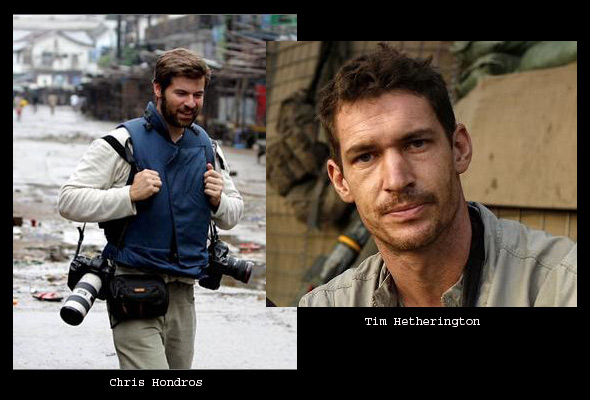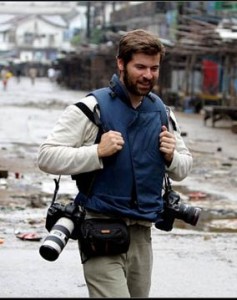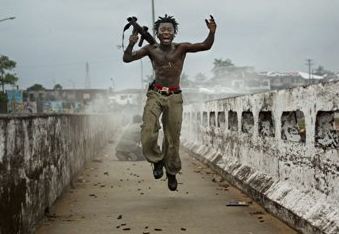I am saddened to report that two of the most prolific and talented war photojournalist of our time, Chris Hondros & Tim Hetherington were recently killed in Libya: This is what the BBC is reporting….
On April 20, war photojournalists Chris Hondros and Tim Hetherington were killed, apparently by a rocket-propelled grenade, while covering the front lines of Libya’s civil war in the besieged city of Misrata.
Although many of you might not know their faces or their names, you are likely to be familiar with their photos. These two individuals brought us images and stories from the front lines of conflict around the world, and died doing what they believed to be important. The journalism world mourns this tragic loss.
- Chris Hondros (if anyone knows who shot this picture of Chris please let me know I would like to show proper photo credit.)
Chris Hondros (born. March 14, 1970) is an American Pulitzer Prize-nominated phtotojournalist. Born in New York City to immigrant Greek and German parents, both survivors of World War II, he moved to North Carolina as a child. After studying English literature at North Carolina State and taking his Master’s degree at Ohio’s School of Visual Communications, Hondros returned to New York to concentrate on international reporting.
Hondros has covered most of the world’s major conflicts since the late 1990s, including wars in Kosovo, Angola, Sierra Leone, Lebanon, Afghanistan, Kashmir, the West Bank, Iraq, and Liberia. His work has appeared on the covers of magazines such as Newsweek and The Economist, and on the front pages of most major American newspapers, including The New York Times, the Washington Post, and the Los Angeles Times.
Hondros has received dozens of awards, including multiple honors from World Press Photo in Amsterdam, the International Pictures of the Year Competition, the Visa Pour L’Image in France, and the John Faber award from the Overseas Press Club. In 2004 Hondros was a Nominated Finalist for the Pulitzer Prize in Spot News Photography for his work in Liberia, and in 2006 he won the Robert Capa Gold Medal, war photography’s highest honor, for his work in Iraq. He’s also been named a 2007 “Hero of Photography” by American Photo magazine, and was a 2008 National Magazine Award finalist.
The story of the above image click here.
In addition to his photography, Hondros is a frequent lecturer and essayist on issues of war, and regularly writes for the Virginia Quarterly Review, Editor and Publisher, The Digital Journalist, and other publications. Hondros and his work are frequently chronicled in the general press, including profiles by Smithsonian magazine, CNN, National Public Radio, The New York Times, and Newsweek. He lives in New York, where he is a senior staff photographer for Getty Images, the international photo agency.
Chis’s image “Exultant Commander” won NPPA’s Best of Journalism 2004. Shot in MONROVIA, LIBERIA – JULY 20: it shows a Liberian militia commander loyal to the government exults after firing a rocket-propelled grenade at rebel forces at a key strategic bridge July 20, 2003 in Monrovia, Liberia. Government forces succeeded in forcing back rebel forces in fierce fighting on the edge of Monrovia’s city center. The story of this image click here.
Tim Hetherington was born in Liverpool, UK. He studied literature at Oxford University and later returned to college to study photojournalism. He lives in New York and is a contributing photographer for Vanity Fair magazine.
- Tim Hetherington
His interest lies in creating diverse forms of visual communication and his work has ranged from multi-screen installations, to fly-poster exhibitions, to handheld device downloads. Known for his long-term documentary work, Tim lived and worked in West Africa for eight years and has reported on social and political issues worldwide.
His project Healing Sport was published by Thames and Hudson as part of group project Tales of a Globalizing World (Thames & Hudson 2003). Long Story Bit By Bit:Liberia Retold (Umbrage Editions 2009) narrates recent Liberian history by drawing on images and interviews made over a five year period. A new book, Infidel (Chris Boot Ltd 2010), about a group of US soldiers in Afghanistan, continues the examination of young men and conflict.
As a film maker, he has worked as both a cameraman and director/producer.
He was a cameraman on Liberia: an Uncivil War (2004) and The Devil Came on Horseback (2007), and his directorial debut film Restrepo about a platoon of soldiers in Afghanistan, was awarded the Grand Jury Prize at the 2010 Sundance Film Festival.
His most recent film Diary is a highly personal experimental short currently playing at film festivals.
He is the recipient of numerous awards including a Fellowship from the National Endowment for Science, Technology and the Arts (2000-4), a Hasselblad Foundation grant (2002), four World Press Photo prizes including the World Press Photo of the Year 2007, the Rory Peck Award for Features (2008), and an Alfred I. duPont award (2009).
Tim Hetherington’s final Twitter post, sent Tuesday, was… “In besieged Libyan city of Misrata. Indiscriminate shelling by Qaddafi forces. No sign of NATO”
It has been a very bad year for journalists covering conflict around the world. Chris and Tim, are only the most recent additions to a growing number of journalist killed bringing us images from the front lines of conflict. Without Chris, Tim and others willing to put their lives on the line, we would have little visual information by which to understand the brutality of war.
As James Nachtwey once said:
In a way, if an individual assumes the risk of placing himself in the middle of a war to communicate to the rest of the world what’s happening, he’s trying to negotiate for peace. Perhaps that’s the reason that those in charge of perpetuating the war do not like to have photographers around.
















I am saddened by this tragic loss. Thanks Karl for sharing this terrible event so eloquently!
Terry
Thank you, Karl. A much better tribute than is offered up by the main stream on line papers.
May they both rest in peace. My prayers goes out to the families and friends. They are gone, but through their amazing work, never forgotten.
If I understand the work of both correctly, their death should be occasion to reflect on our consumption of war reporting. Do we really need so many pictures to understand the cruelty of war? Can one understand at all what it means to live in war or how it cames to the state of war ? I know war and I do not think so. Just some pictures are so extraordinary, works like Restrepo so elementary, that they really can turn the page.
Thank you for your attention to the many “unnamed” journalists around the world, which dies, get wounded, are captured and hijacked. When I use the website of “Reporters without borders”, it makes me very sad. And it makes me also proud that there are people who risk everything and try to enlighten the world. This is progress for the humankind.
Happy Easter!
Thanks for sharing this with us. Karl. We are truly indebted to those who risk their lives so that we may see what life is like for those beyond our borders. Be safe out there.
Wow, it saddens me even more with what was his last twitter statement. So freaking sombering.
So much needs to be done in that country, wish we could save more lives.
Thanks for the reverent post Karl, insightful and interesting as always.
Thanks for sharing…the journalism world lost two diamonds which is hard to replaced.
Karl,
Great work. Thanks for the story. I’m fascinated by people so dedicated to a cause. Very said indeed.